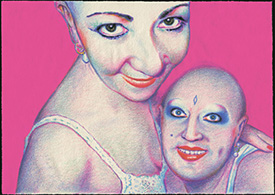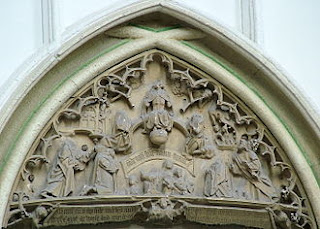"Three Dimensions"
For our final project for Art and Technology class (*sob*) we had to create our own video art that would be at least one minute long (excluding credits) and less that three minutes long (including credits). It had to be somehow related to "Video Deconstruction."
I must admit that I first I had no idea what to do for my video art project. I had never edited nor even handled with video before (except the for the Performance Art piece), so I was not sure what to do. One night I decided to experiment with my Mac's video camera and the effects that were available in Photo Booth, recording myself with the different special effect. Suddenly I remembered professor Echeverry's example in class, and, inspired by it, I did this: I recorded myself, using my Mac video camera, with my iPad also in video recording mode. This created the same effect that happens when two mirrors are placed facing each other! Then integrated the special effects in Photo Booth and amazing visuals were created. I then knew what I was going to do for my project. I recorded myself every night, doing different things until I decided that it was time to create the video art piece. I used the best recordings of myself and rearranged them in a sort of sequence, using iMovie. I also made the audio using Garage Band, synchronizing it with the video. I must admit that it was rather fun doing it; it really kept my creative juices flowing.
Anyways, I want to talk more about the video art piece itself. I titled it "Three Dimensions" because it focuses on three effects from Photo Booth that I used, each seeming as I was in a different realm (with the projection effect). Actually, I came up with the name inspired by Marco Brambilla's "Civilization", in which heaven and hell are demonstrated in an eternal loop. The different "dimensions" and "realms" that Brambilla presents led me to title my piece "Three Dimensions." It really came out of nowhere but I believe it suits it. So, in terms of the "video deconstruction" aspect, there are many things to consider. First of all, for me "deconstruction" means the separation, division or the taking of a part of a whole and rearranging them in some other way (with the possibility of adding something as well). The first thing of technical deconstruction in the video is the quick cutting, since I took and "separated" small parts of the original recording and placed them in different order and speed. In other words, only small fragments of the part are seen and changed quickly (fragmentation). Going deeper and more abstract, I believe that each part or "dimension" includes some kind of deconstruction, even if it is just a moment. The first one, the one with the negative effect, I see the fact that the original person is negative while the negative of that one is displayed on the smaller person and so forth as an abstract deconstruction. The "negative" is actually separated from the "positive." It may not make much sense, but I admit that I see it that way. On the second one, I believe that there is deconstruction, since each projection of myself, as it gets smaller, is even more altered and deconstructed. It slowly becomes less distinguishable and fragmented. I must admit that I really cannot find some sort of deconstruction on the third one, yet I believe that it is one of the most powerful ones.
So, it may seem rather simple but believe me: it was way harder than it looks!
I really hope you like it!
Good night and good luck with your final exams/projects! (If you have any that is.)
Sincerely,
Michelle

































